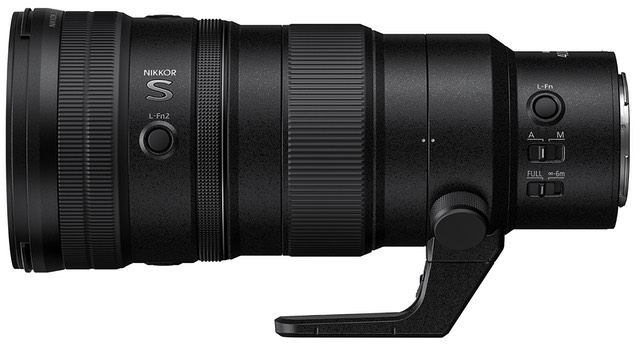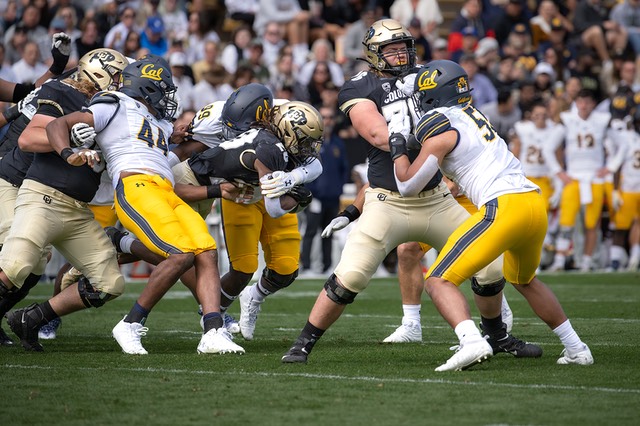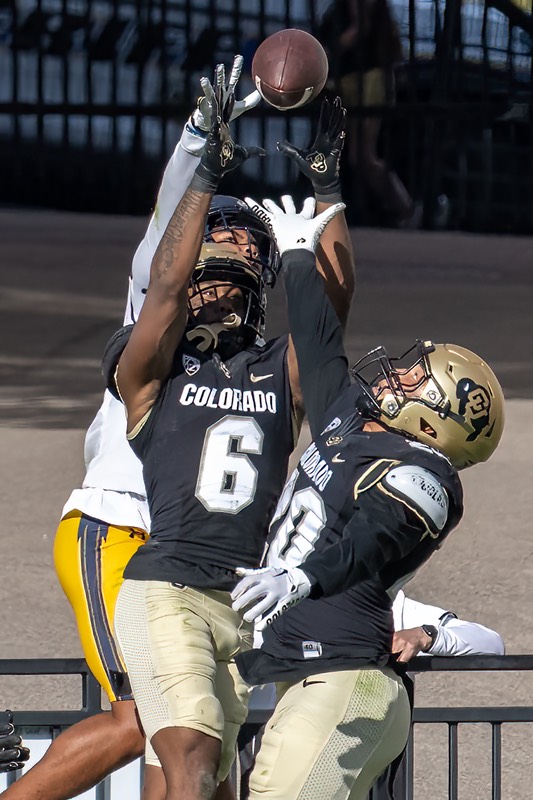
What is It?
While the 400mm f/4.5 VR S wasn't exactly a surprise—a 400mm something was in the recent Road Map—the actual announcement did raise quite a few eyebrows. Here Nikon was announcing a lens shorter than you'd expect for the 400mm focal length, quite light, and yet it didn't use Nikon's proven PF optics.
Just how did Nikon pull that off?
By changing the optical design from previous telephoto lenses.

If you look at the 400mm f/4.5 VR S (left) compared to the 400mm f/2.8 TC VR S (right), you'll see that something changed at the back end of the optical design. In most telephoto designs Nikon (and others) has used, the front of the lens to the focal plane in the camera is about the same measurement as the focal length of the lens.
I don't want to get deep into an optical engineering discussion, so I'll simplify things by saying that the usual telephoto design takes the light entrance from the front of the lens and then uses a cone-like presentation of the light from there to the focal plane. A front positive group (front two elements) and a subsequent negative group (second five elements) do most of the "telephoto work". But note the slowly-narrowing elements after those first two groups in the 400mm f/2.8 TC VR S (right) until you get to a final group that's presenting the optical path without curvature and making it more telecentric to the focal plane. Also there's a bigger separation and grouping in the negative group in the middle.
In the 400mm f/4.5 VR S (left), you'll note instead that there's a more complex and slowly growing in size set of elements at the rear after the negative group up front. This comprises some sort of complex converter group that allows for shortening the overall lens length. That results in a total of 19 elements in 13 groups for the 400mm f/4.5 VR S, while for the 400mm f/2.8 TC VR S it is 18 elements in 15 groups. The yellow elements are ED elements, the dark purple ones are FL elements, which the f/4.5 doesn't have. The red elements are Super ED elements, and the light purple ones are SR elements. Note that all this special glass is up front on the f/4.5, where it's attempting to make the different colors of light align prior to the converter group.
The fact that the 400mm f/4.5 VR S uses ED (and Super ED) glass instead of FL (Fluorite) or PF (Phase Fresnel) means that the big elements are easier and less expensive to produce. Which is one reason why the 400mm f/4.5 VR S comes in at a reasonable price and why I expect the lens to be available in larger volumes more quickly than we saw with all the lenses that have FL and PF elements.
Nano lens coating is used on the 400mm f/4.5 VR S to reduce flare, and the front element has Nikon's recent fluorine coating to repel things like moisture and dust. The aperture diaphragm is 9-blades, and the minimum aperture is f/32.
The 400mm f/4.5 VR S can be used with the 1.4x and 2.0x Z-mount teleconverters, which provides the options of 560mm f/6.3 and 800mm f/9 capability. Front filter size is 95mm, by the way, probably a size you don't own.
As I noted, this new lens is shorter than you might expect for 400mm: 9.3" (234.5mm). The f/4.5 aperture makes the overall diameter come in at 4.1" (104mm). This is a lens that easily fits into virtually all of my backpacks, including the 16L Gura Gear. It does so with space to spare. The lens is also light for a 400mm optic at 40.9 ounces (1160g) without foot or hood. Having dragged a 10.2 pound 400mm lens around Africa and stadia sidelines for a number of years, the 2.6 pounds of the 400mm f/4.5 seems like a flyweight. Of course, I'm giving up a stop and a third in aperture for that nearly three-quarters weight reduction. Note that the Nikon-supplied tripod foot and lens hood adds 217g, so the grand total weight in use is usually 48.6 ounces (1377g).
But compare that weight to the 100-400mm! The 100-400mm f/4.5-5.6 VR S with foot and hood is 50.7 ounces (1437g). And the zoom is 36mm longer when used at 400mm. Nikon really did a compacting job on the 400mm f/4.5 VR S. So much so that when I use it on the sidelines for football (see recent images, below), I'm not using a monopod to support it as I have to do with my 400mm f/2.8 TC VR S.
I'm spending more time than usual on size and weight in this review for a reason: it's one of the primary things you'll notice immediately upon receipt of this lens, and if you can deal with the f/4.5 maximum aperture, the small size and weight are going to transform your use of a 400mm prime.
While we're talking about weight, the 85g tripod foot mounts into a built-into-the-lens rotating collar the same as the 70-200mm f/2.8 VR S and 100-400mm f/4.5-5.6 VR S lenses (which I don’t like the design of, as it’s too easy to dislodge). Thus, you could buy one Arca-compatible foot and share it between lenses. I'm using the Kirk LP-70 on my 400mm f/4.5 VR S, but you have many different choices available from a wide range of vendors, including Really Right Stuff and Wimberley. As with other recent telephoto Z-mount lenses, there's a Kensington-style security slot under the knurled tripod collar knob's lid.
The lens is weather sealed at eight key locations around the lens, plus at all control locations.
Close focus on the 400mm f/4.5 VR S is one thing that you'll find that has been compromised slightly (from the 100-400mm f/4.5-5.6 VR S and 400mm f/2.8 TC VR S): close focus is only 98 inches (8.2 feet, or 2.5m). That puts the maximum magnification at 1:5.6 (the 400mm f/2.8 TC VR S is 1:3.9, and the 100-400mm f/4.5-5.6 VR S is 1:2.5, which is close to macro territory).

Speaking of focus, this is done via a stepper motor, not the voice coil motor of f/2.8 lens. There's a broad, 29mm wide, fly-by-wire manual focus ring by which you can override focus. On the Z6 II, Z7 II, and Z9 with current firmware, you can vary the response speed of the focus ring. You'll also find the usual A/M focus switch, plus a focus limiting option (Full or infinity to 6m) on the 400mm f/4.5 VR S. Surprisingly, there's a Memory Set button on the shutter release side of the lens you can use to preset a focus position (and then use other buttons to recall that set distance).
Despite being an S-line lens, the 400mm f/4.5 VR S doesn't have the typically useless LED display to give you vague and misleading focus distance and DOF information. But you do get one L-Fn and four L-Fn2 buttons, plus an extra programmable control ring.
The 400mm f/4.5 VR S also has built-in lens VR (vibration reduction), which Nikon specifies as "Syncho-VR." Synchro-VR works with the Z9 and nets another half stop of CIPA stabilization results (6 stops versus 5.5 stops). Too bad Nikon hasn't exactly documented what Synchro-VR is, how it works, exactly which camera/lens combos trigger it, and what it actually improves. However, it seems that all of the exotic and near-exotic telephoto lenses are now supporting Syncho-VR. As with all Z-mount in-lens VR implementations, there is no switch to control VR on the lens.
The 400mm f/4.5 VR S is made in China and lists for US$3250. A lens hood and tripod foot are supplied with the lens, along with a cloth wrap case (If you want a carry case similar to that supplied with the 400mm f/2.8, see ApeCase; also the JJC DLP-7II lens case fits the 400mm f/4.5 [Amazon Link; As an Amazon Affiliate I earn from qualifying purchases].
Source of reviewed lens: purchased via NPS Priority Purchase program.
How's it Handle?
With one exception, I have no quibbles with the handling of this lens.
Let's start with the good news: I can press one of the L-Fn2 button(s) with my left thumb while still being able to spin either control ring with my index and middle fingers, all while supporting the lens with my left hand. Thus, using a Hybrid AF technique on the Z9 is straightforward with the lens fully supported in hand held work.
As noted, the tripod foot mount is the same as on other Z-mount telephoto lenses (other than the 400mm f/2.8 TC VR S and 800mm f/6.3 PF VR S, which use a different and more permanent foot attachment system), so some accessories you have already purchased might work. The small size and the light(ish) weight of the 400mm f/4.5 VR S also mean I tend to take the tripod foot off a lot, and the lens handles quite well when hand held.
The lens hood is one of Nikon's nicest for a long telephoto, with a rubber front lip, while not being too deep or too large a diameter. It's pretty bag friendly for those that travel.
So what's the exception? The L-Fn button, basically (the 800mm f/6.3 VR PF has this same issue). You will move your hand position to use it (or you will move your hand position to use the control rings). Why that button isn't between the two control rings you'll have to ask Nikon engineers, who probably took the "easy" route in how information is routed in the lens and how control seals work. Again, the lens has a Memory Set button, so it would be nice to be able to have quick access to memory recall via a customization button. But if you put that on the L-Fn button—which I do—you're moving your hand to recall focus position.
Moreover, we're now starting to get into "banks" issues again. At present, I want both my 400mm lenses programmed somewhat differently due to button positions. Oh, oh. That means I have to dedicate banks to specific lenses. I don't have enough banks for that, there's no way to load banks from a card, and...well, you know where I'm going with this: Nikon once again is not talking to photographers and understanding just what we want done with controls, let alone how to let us configure them quickly while photographing.
That said, if the 70-200mm f/2.8 VR S, 100-400mm f/4.5-5.6 VR S, 400mm f/4.5 VR S, and 800mm f/6.3 VR PF S were my main lenses, I probably could configure my camera one way for lens controls and be happy. It's that pesky 400mm f/2.8 TC VR S that's the current (and hopefully last) exception that causes me real configuration problems. So I'm not going to ding the 400mm f/4.5 VR S for handling, just note that the hand position for the L-Fn button is not optimal.
How's it Perform?
Focus: This isn't the lens for video: clear and considerable focus breathing on a significant focus pull is visible (approximately 10% frame change). I've seen others report otherwise, but they couldn't have been doing much of a pull.
In terms of focus speed, the 400mm f/4.5 VR S is one of the fastest focusing telephotos Nikon has that work on the Z system. It's tough to measure, but I believe the f/4.5 to be slightly faster than the f/2.8 version of the lens, despite not having the fancier and more expensive voice coil motor of the latter. The 100-400mm f/4.5-5.6 VR S may be the fastest of the 400mm options in terms of focus acquisition on a Z6 II or Z7 II, but it's not by much, and on the Z9 this seems to reverse; many won't even notice these small differences in focus speed. The 400mm f/4.5, if it has a focus liability, does tend to track a little slower than the other options on fast, erratic motion. I suspect this is due to the simple stepper motor versus the voice coil on the f/2.8 lens. My hypothesis would be that the voice coil stops and reverses faster than the stepper.

Sharpness: Wide open I'd rate the lens as excellent in the center, and excellent- in the corners. Stop down any small amount and let's just call it excellent edge to edge. You only have to get to f/5.6 to get the best results the lens is capable of. The 400mm f/2.8 TC VR S, however, still tops the f/4.5 version a bit at the same apertures. There's super clear contrast snap to the f/2.8 that's just a small bit less in the f/4.5 version when used at the same aperture.
Stopping the 400mm f/4.5 VR S down, a strange thing happens (see also my teleconverter comment, below). Near the DX boundaries stopping down adds some clear acuity and resolution; at the corners, stopping down shows only just a bit of change. Best aperture, the DX boundary strongly considered, might even be f/8 for some, but the gains are marginal and you're now nipping at diffraction on the 45mp bodies.
Compared to the 100-400mm f/4.5-5.6 VR S at 400mm f/5.6, the 400mm f/4.5 VR S is somewhat better wide open, pretty much across the board, and clearly better at the same f/5.6 aperture.

Here’s the full frame from one of my Colorado versus California football photos. I was following the runner with the ball (using hybrid AF technique). Is the 400mm sharp? Let’s look at something closer to actual pixels:

That would be a yes. Does the sharpness hold up at longer distances?

Yes. And this is a strong crop from well more than 80 yards away across a hot field and a warm day (thus atmospherics come into play). I was focused on the Cal player crossing left to right, thus the slight blur on the Colorado players in front. Go Buffs.
Note that at minimum focus distance the corners absolutely degrade wide open, and the overall impression even at the center of the frame is that there is an acuity loss. Stopping down to f/8 solves the center frame issue and greatly improves the corners, but I wouldn't characterize this lens as one you'd want to use on flat subjects at close distance.
With teleconverters, things degrade, as you'd expect. Wide open with the 1.4x converter (560mm f/6.3), I'd put the center at very good+, and the far corners at the boundary between good and very good. That's surprisingly better than I was expecting, and it suggests that just buying a 400mm f/4.5 VR S and a 1.4x teleconverter is absolutely the average person's 400mm f/2.8 VR TC S. Yes, you're a stop+ down from the expensive exotic, but your optical performance is reasonably close (and still quite good) at only about 1/4 the cost. Close, but not as good; the 400mm f/2.8 VR TC S with its 1.4x flipped in is clearly better at 560mm f/5.6 than the 400mm f/4.5 VR S with and added 1.4x teleconverter (which puts it at f/6.3).
Compared to the F-mount 500mm f/5.6E PF, the 400mm f/4.5 VR S with a 1.4x teleconverter (560mm, so not perfectly comparable) seems to do slightly worse in the center, slightly better in the corners. For most telephoto work, sharper centers is what you want, so don't throw that 500mm PF away just yet ;~).
Finally, the 400mm f/4.5 VR S is a little better with a 1.4x teleconverter than the 100-400mm f/4.5-5.6 VR S, but both are quite good. In the F-mount world I was not a fan (or user) of teleconverters. In the Z-mount world, I'm coming around to liking (and using) them, at least the 1.4x version.
I was hoping for a bit more with the 2x converter (800mm f/9), but on my top bodies we're also now recording diffraction quite well, so results were never going to have the acuity you'd see without the teleconverter. I'd characterize the results as pretty much good- across the frame, with the surprise that the center is ever so slightly worse than the near perimeter around it. By comparison, the 400mm f/2.8 TC VR S with the 2x is clearly better in the center out through the rule of thirds points than the 400mm f/4.5 VR S with the 2x. The 800mm f/6.3 VR PF S is simply the best choice if you need 800mm. Still, I'm not dissatisfied with the 400mm f/4.5 VR S and a 2x in a pinch. It's right on my "usable" boundary.
I’ll have much more to say about this soon, as I took the time recently to pull out all 200mm, 300mm, 400mm, 500mm, 560mm, 600mm, 700mm, and 800mm options and run them through a couple of rounds of side by side testing. Article coming...
Field curvature is essentially zilch. As with other recent Z Nikkors, I'm not seeing any falloff in results when focusing at a distance. At maximum close-up magnification the lens is also holding sharpness in the center out through the DX frame boundary. To bring in the corners, stop down to f/8.
Coma is as well corrected as I've seen in a telephoto, as is spherical aberration. The 400mm f/4.5 VR S is our first astrophotography telephoto!
Linear distortion: Very mild pin cushion (a bit less than 1%), to the point where I'd probably just ignore it.
Chromatic Aberration: A small trace of longitudinal CA appears, though not enough for me to worry about that impacting results in a way I'd want to correct. Moreover, it's basically nil at f/5.6. Lateral CA is low and negligible.
Vignetting: Generally very good, with perhaps a bit more than a stop of darkening that's mostly limited to the corners wide open. By f/8 that vignetting is gone, and I mean gone. The in-camera lens corrections don't take out all of the vignetting, though, but does remove it to the point I'd ignore it.
Flare: I'm not seeing any flare issues with the hood on. Note that any stopping down tends to produce sunstars on bright lights in frame, and a high number of them.
Bokeh: A lot to like, one thing not to. Virtually no onion-skinning with only a slight brightness to the rim of specular highlights. However, cats eye shows up outside the DX frame, and significantly so in the corners. I also see some clear clipping beyond the cats eye, indicating that there is a light baffle intruding. That said, the overall impression of the focus to out-of-focus falloff is quite good. For the subjects we're likely to photograph with the lens, I see very nice bokeh that doesn't call attention to itself (but watch out for out of focus highlights in the corners).
Final Thoughts
When the box first arrived with my UPS delivery person, I wondered whether someone had stolen the lens inside, as even well packaged everything seemed to be much lighter than expected. I mean, this is a 400mm f/4.5 VR S, it has to have some substance in mass, right?
Not right. This is a very light lens for its focal length. Everyone I’ve had pick it up says the same thing: wow.
So let me say this first: if you haven't already purchased a 500mm f/5.6E VR PF (and are using it on your Z-mount camera via an FTZ), then your light, highly competent telephoto has arrived. Buy the 400mm f/4.5 VR S and a 1.4x teleconverter, and you'll have a very high performing set of telephoto options at a truly small size and weight (less than the 500mm, as you have to consider the FTZ adapter). If you already have the 500mm, I'd probably say just hold onto it and get the 100-400mm f/4.5-5.6 VR S for some flexibility and close focus work. Unless, of course, you are always leaning on a teleconverter, in which case the 400mm f/4.5 VR S is the slightly better choice over the 100-400mm f/4.5-5.6 VR S.
If you are looking for something you can afford that doesn't max out all your credit cards, the 400mm f/4.5 VR S is the right choice for those that were lusting for the 400mm f/2.8 TC VR S. I'm not giving up my 400mm f/2.8 TC VR S, mind you, it's simply the best 400mm and 560mm combo you can get in the Z-mount at the moment, has the ability to throw backgrounds more out of focus, plus with the 2x teleconverter it's a near 800mm f/6.3 PF S equivalent. Once that f/2.8 lens got mounted to my Z9, I wasn't taking it off (except to test other lenses). However, I can conceive of times when I have to travel lighter and with smaller bodies; the 400mm f/4.5 VR S is going to be what I turn to in those cases.
Here's the thing: for most people, the correct telephoto high-quality options to buy are the 70-200mm f/2.8 VR S, the 400mm f/4.5 VR S, and a 1.4x teleconverter. That nets you a quality 70-200mm f/2.8, 105-280mm f/4, 400mm f/4.5, and 560mm f/6.3. Do you really need more?
Nikon's been nailing the Nikkor lineup, producing best-in-class after best-in-class efforts here in the mirrorless world with the various S lenses. The 400mm f/4.5 VR S is no exception. I marvel that Nikon kept the optical attributes so high while reducing the size and weight so much. The 400mm f/4.5 VR S is not matched by any competitor I know of. It's the right lens for quite a few of you wanting to range beyond 200mm.
Thus you probably won't be surprised* by my rating:
Highly Recommended (2022 to present)
*Okay, those of you reading my 400mm f/2.8 TC VR S review probably are. You're still wondering why I dinged that faster lens a notch. It all gets down to capability versus handling. Yes, I don't like the position of the L-Fn button on the 400mm f/4.5 VR S. However, my hand position isn't changing when I use the L-Fn2 buttons and the focus ring. I can roll both control rings while still reaching one of those L-Fn2 buttons without changing hand position. With the f/2.8, the controls are scattered and too far apart, and I have to move my hand position to effectively use them, which diminishes the value of all those extra controls. As many of you know, I use a hybrid AF approach on the Z9. That's well supported by the 100-400mm f/4.5-5.6 VR S and 400mm f/4.5 VR S, but not so much by the 400mm f/2.8 TC VR S. You can't get my top rating by disabling something I would use all the time.
Support this site by purchasing from the following advertiser:
